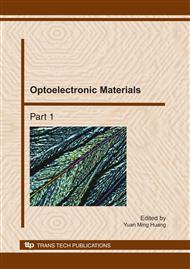p.1107
p.1111
p.1115
p.1121
p.1125
p.1129
p.1133
p.1137
p.1142
Controlled Synthesis of Fe3O4 Nanosheets via P123 Micelle Template
Abstract:
Magnetic iron oxide nanomaterials (e.g. Fe3O4 and γ-Fe2O3) with different morphologies have aroused extensive attention due to their fundamental research and potential technological applications such as magnetic recording media, magnetic fluids and magnetic drug-targeting. In this article Fe3O4 nanosheets were successfully synthesized using triblock copolymer (PEO)20(PPO)70(PEO)20 (P123) micelles as structure-directing agents in the presence of surfactant-assisted ethylene glycol (EG) and precipitator hexamethylenetetramine (HMTA) at 70 °C for 2 h in N2. The Fe3O4 nanosheets have irregular shape with thickness of the Fe3O4 nanosheets about 10-15 nm. The X-ray diffraction (XRD) pattern confirms the Fe3O4 nanosheets have magnetite structure and its nine distinguishable diffraction peaks can be perfectly indexed to the (111), (220), (311), (222), (400), (422), (511), (440), and (533) planes of the fcc structure of magnetite. Its saturation magnetization (σs) is 58.4 emu/g. The possible formation mechanism of the Fe3O4 nanosheets in present work is proposed.
Info:
Periodical:
Pages:
1125-1128
Citation:
Online since:
November 2010
Authors:
Price:
Сopyright:
© 2011 Trans Tech Publications Ltd. All Rights Reserved
Share:
Citation:


